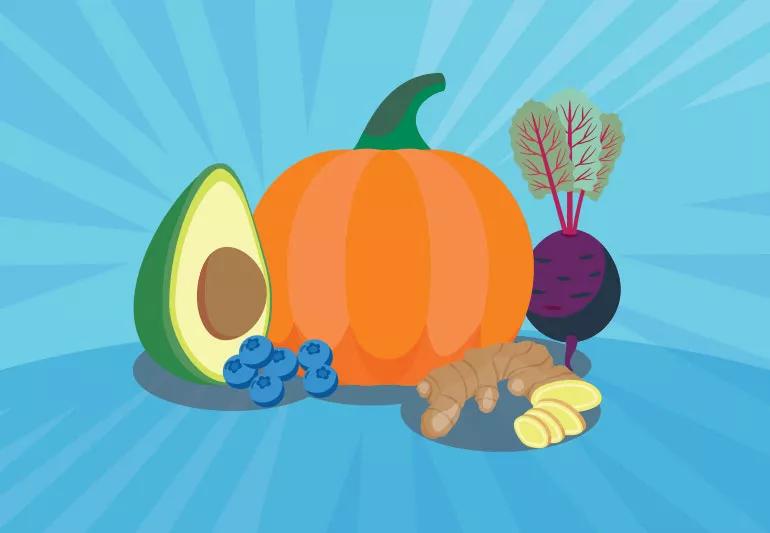Plus, recipes to incorporate them into your daily diet

No single food can do it all — but it goes without saying that some foods are healthier than others. A leafy salad is healthier than a plate of fries; a salmon filet is healthier than a loaded cheeseburger; a yogurt parfait is healthier than a hot fudge sundae.
Advertisement
Cleveland Clinic is a non-profit academic medical center. Advertising on our site helps support our mission. We do not endorse non-Cleveland Clinic products or services. Policy
Even among healthy foods, though, some stand out. Registered dietitian Beth Czerwony, RD, talks about superfoods, a category of super-charged, super-healthy foods, and what they can do for your body.
Superfoods aren’t a nutritionally recognized category of foods, so there are no specific criteria a food must meet to be considered one. But the title is typically reserved for natural foods that are especially nutrient-dense while generally being low in calories.
“Superfoods help promote health by increasing your immune function and decreasing your chance of disease prevention or progression,” Czerwony says.
Each superfood has different nutritional properties, but overall, they’re associated with:
Superfoods are, in a sense, exactly what they sound like: a category of foods that are super-healthy. But not every healthy food is a superfood.
“Superfoods are those that offer exceptional health benefits, beyond what you’d expect based on just their nutritional profile,” Czerwony explains.
In particular, superfoods are rich in:
Advertisement
Superfoods may also be high in:
“Most superfoods come from plants, but some fish and dairy make the cut, too,” Czerwony says. She shares some of the most popular superfoods and what makes them so, well, super.
Don’t let anyone shame you out of your love of avocado toast. “Avocados are rich in heart-healthy monounsaturated fats, which reduce your risk of heart disease and stroke,” Czerwony says. Just one avocado contains more potassium than a banana — and the health benefits of avocados go on and on.
Add avocado to your diet: Sauteed Veggies with Avocado and Poached Eggs will fill you with healthy fats and tons of nutrients. You can even work avocado into desserts, like decadent but healthy Avocado Brownie Bites.
Loaded with flavonoids, the American Heart Association says berries can help lower the risk of heart attacks in women. Berries in the superfoods category include:
Add berries to your diet: The easiest way to eat berries is, of course, to just eat berries. But you can also start your day with a Berry Smoothie Bowl or make your own Cinnamon Cranberry Sauce as an accompaniment or side.
These root veggies get their jewel-toned coloring from betalains, a natural plant pigment that contains antioxidants and is associated with anti-inflammatory properties. “Chronic inflammation in the body is linked to diseases like Type 2 diabetes, high blood pressure, heart disease and asthma,” Czerwony says.
Add beets to your diet: Dip your favorite veggies into Beet Muhamarra, or whip up a stunning side of Roasted Beets with Oranges. You can even make beets the focal point of your meal with Meatless Beet Burgers.
These teeny-tiny seeds, which come from a flowering plant native to Mexico and Guatemala, are a good source of fiber, protein and antioxidants, as well as vitamins and minerals like phosphorus, magnesium, iron and zinc. At just 100 calories per ounce, they’re also a low-calorie food.
Add chia seeds to your diet: Toss ’em into a smoothie, oatmeal, or Chia and Berry Breakfast Pudding, or add a healthy punch to chia seed muffins.
Advertisement
Your favorite cozy spice is a healthy one, too! Cinnamon is known to reduce inflammation, blood sugar levels and cholesterol. It’s also a staple of the Mediterranean Diet, a heart-healthy eating style rich in herbs and spices.
Add cinnamon to your diet: Put cinnamon in whatever you please, including oatmeal, coffee and more. Low-Cal Baked Cinnamon Apples are a tasty fall favorite, and Pumpkin-Apple Chia Muffins mix multiple superfoods for an autumnal breakfast or snack.
It’s no surprise that salads are healthy. But skip the iceberg lettuce and go for dark, leafy greens, which are packed with vitamins A, C, and E and may prevent cancer. “They’re also high in vitamin K, which is good for bone health, and folate, which promotes heart health,” Czerwony says.
There are plenty of greens to choose from, which includes but isn’t limited to:
Add dark, leafy greens to your diet: Keep your simple salad simple but supercharged with Tossed Green Salad with Simple Vinaigrette Dressing, or switch it up with Asian-Season Mustard Greens. You can have your greens for dessert, too, with a Creamy Strawberry and Greens Smoothie.
Advertisement
This flavorful veggie is known to boost immunity, work as an anti-inflammatory, improve cardiovascular health and more — not to mention, it adds a tasty kick to just about any dish.
Raw garlic is healthier than cooked garlic, but fermented black garlic, which is packed with powerful antioxidants, may be the healthiest of them all.
Add garlic to your diet: Toss garlic into your stir-fries, soup and just about anything else you desire, or put it front and center with Roasted Garlic, Zucchini and Tomato Bake or Crushed Garlic and Basil Bruschetta.
This popular spice contains vitamin C, magnesium and potassium. The many health benefits of ginger also include pain relief and blood sugar regulation, not to mention nausea relief when you’re sick (hence Mom insisting you sip ginger ale when you’ve got an upset stomach).
Add ginger to your diet: Sprinkle it on veggies, in stir-fries and soups and even in your hot tea. Can’t get enough? Blend up a Ginger Spice Smoothie or make a batch of Ginger Sweet Potato Pancakes.
“Green tea leaves are loaded with catechin, an antioxidant compound with anti-carcinogenic properties that helps protect your cells from damage,” Czerwony says.
Green tea is also associated with preventing cancer, fighting heart disease and lowering blood pressure, to name just a few benefits.
Advertisement
Add green tea to your diet: Enjoy a calming, caffeine-free mug of green tea any time you need a boost. Want to switch it up? Try this Green Tea Infused With Apples and Cinnamon.
These little low-cal legumes are high in protein, which is vital for cellular repair, making them a suitable swap for meat. Bonus? They’re also loaded with folate, iron and potassium.
Add lentils to your diet: Make them the star of the show with entrees like Lentils with Roasted Curry Tomatoes and Curried Cauliflower Lentils with Cucumber Raita. Or serve them on the side in Crunchy Bistro Lentil Salad
This Thanksgiving favorite is for more than just pie. “Pumpkin is rich in lutein and zeaxanthin, antioxidants that protect your eyes from age-related issues like macular degeneration and cataracts,” Czerwony says.
Among its other health benefits, pumpkin is also loaded with antioxidants and potassium, which can help prevent heart disease. One cup of pumpkin contains 16% of your daily recommended amount of potassium.
Add pumpkin to your diet: Get cozy with Pumpkin Lentil Soup (two superfoods in one!) or swap your favorite fall desserts with healthy pumpkin recipes. And don’t toss those pumpkin seeds, which are packed with health benefits of their own.
The American Heart Association recommends eating two servings of fish each week. This particular fishy favorite is high in omega-3 fatty acids, which can help prevent heart disease — and which your body can’t make itself.
Add salmon to your diet: Your best bet is to stick to wild salmon. There are just about as many delicious salmon recipes out there as there are fish in the sea, so pick your favorite and enjoy!
Yogurt and kefir (a fermented milk drink) are probiotics full of good bacteria that support gut health, and they’re also a good source of calcium and protein. They’re associated with cancer prevention and immune system stimulation.
Add yogurt and kefir to your diet: Make sure to choose yogurt without added sugar (Greek yogurt is best), then try easy Fruit and Yogurt Parfaits. You can make kefir on your own or find it in the yogurt aisle at your grocery store.
Next time you’re meal-prepping or grabbing a snack, turn to superfoods for that extra wallop of the good stuff. Your body will thank you!
Learn more about our editorial process.
Advertisement

With a focus on internal cues for hunger and fullness, this eating style may revolutionize your relationship with food

Review the ingredients, watch for sugar and fat, and choose one with the right amount of protein for your needs

A typical recommended balanced diet is half fruits and veggies, a quarter protein and a quarter grains

Foods high in protein, fiber and water can help keep hunger at bay

This quirky food trend is harmless, as long as you’re getting enough protein, fiber and healthy fats

Wrapped or sandwiched, try to choose fillings and condiments that are minimally processed, low in saturated fat and high in fiber

Set yourself up for success by carefully choosing your recipes, storage containers and prepping day

These breaks may have some benefits — but they promote an unhealthy attitude toward food

If you’re feeling short of breath, sleep can be tough — propping yourself up or sleeping on your side may help

If you fear the unknown or find yourself needing reassurance often, you may identify with this attachment style

If you’re looking to boost your gut health, it’s better to get fiber from whole foods